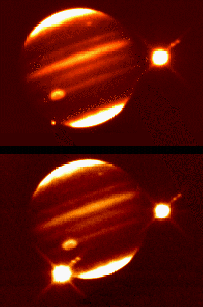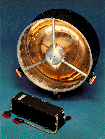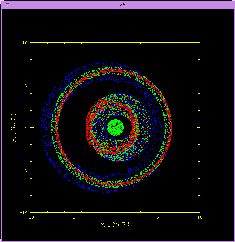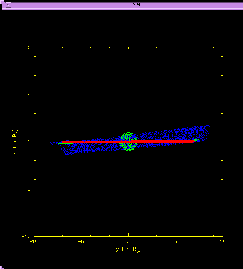Doug Hamilton's Research Interests

In my research, I attempt to use classical physics to understand basic
features of the solar system. Depending on the specific requirements
of a given project, I develop theory, do computer modeling, make
telescopic observations, and/or analyze spacecraft data. Below is
list of the general areas in which my research is focussed as well as
some specific projects. More details can be found in my Scientific Publications and in my
Recent Talks. See also my
Cover Images. There is always more to
say, and so I will be adding more to this page as time permits!
- Theory and Computer Modeling
- Telescopic Observations
- Spacecraft Data


SL9 Movies!!
Gallery of SL9 Images
There is lots of good SL9 stuff at JPL's SL9 Home
Page. Here, for example, are the Top 20 SL9
Images requested over the internet during impact week. Our first
A image from
the Calar Alto Observatory is number 1!
These images are brought to you by the Calar
Alto SL9 Team.

What Do They Do?
-
The dust detector subsystem (DDS) aboard the Ulysses and Galileo
spaceprobes records the impacts of submicron and larger dust grains in
interplanetary space. The arrival direction, impact velocity, and
particle mass are measured for each high-velocity impact. Study of the
resulting datasets allows us to learn about the interplanetary dust
complex, dust around planets, and the two new populations discovered
by these instruments: Interstellar dust and jovian dust streams.
The Discovery of Interstellar Dust
-
Interstellar dust flowing through our solar system at speeds of about
25-50 km/s form the dominant population of large particles (0.4
microns in radius) sensed by Ulysses and Galileo beyond 3 AU from the
Sun. Interstellar dust is easy to recognize since it all arrives from
a single direction in space in contrast to interplanetary dust. Within
3 AU the signature of interstellar dust fades; is it just
that interplanetary dust dominates or are interstellar dust grains
actually excluded from the inner solar system?
The Discovery of Jovian Dust Streams
- In the vicinity of Jupiter, tiny grains streaming away from the
giant planet dominate the flux sensed by Ulysses and Galileo. The flux
is periodic, collimated, and very intense. Maximum count rates for
Galileo were on the order of 10,000 times interplanetary norms. Directional
information point to a jovian source, and theoretical modeling suggests
that tiny charged grains are ejected from the system by strong electromagnetic
forces.
Want to know more? Check out the DDS Home Page.
The Galileo/Ulysses/Cassini
DDS Team Meeting was held here at the University of Maryland
May 27-29, 1998.
Non-Gravitational forces strongly influence the orbital motions of
dust both in planetary rings and in interplanetary space. These forces
typically become important for dust grains a few microns in size, and
dominant for grains a few tenths of a micron in size.
Electromagnetic effects are important in shaping the jovian
ring and Saturn's E and G rings, cause the jovian system to emit
high-speed dust streams, eject tiny dust grains out of the solar
system, and deflect small incoming interstellar grains.
Radiation Pressure helps to shape Saturn's E ring and the
putative martian rings, causes dust to form elegant comet tails, and
sweeps the environs of asteroids free of millimeter and smaller
objects. Various Drag Forces broaden the jovian
ring, cause interplanetary grains to spiral into the Sun, and bring
dark dust from Phoebe inward to icy Iapetus to create the striking
black/white asymmetry seen on that satellite (see below).
Dusty rings and small satellites are intimately related since impacts
of interplanetary micrometeoroids into small moons eject significant
amounts of debris into circumplanetary orbit. These become ring
particles which usually end their lives by striking the embedded
moonlet, sometimes energetically enough to release still more debris.
Steady state is established with losses balancing production while
perturbation forces govern the shape and structure of the rings. This
interplay is particularly interesting at Mars, where the moons Phobos
and Deimos are predicted create a faint ring of debris whose evolution
is dominated by radiation pressure and planetary oblateness. On May
28, 2001, we used the Hubble Space Telescope to look for these
rings. Unfortunately, we found no new rings or moons in our search,
which was 3000 times more sensitive than the one done with the Viking
cameras. The new upper limit on the Mars rings makes them fainter than the faintest ring material that we have seen anywhere in the Solar System.
Do Mars rings exist? Almost certainly, they are just exceedingly faint!

This image (click for higher resolution) shows the
distribution of 40 (blue), 100 (green), and 250 (red) micron grains in
the martian rings as seen from above Mars' north pole. The rings are
displayed in a rotating frame with the Sun off to the right side of
the plot. Note that:
- The Deimos ring (outer) is displaced away from the Sun.
- Smaller particles from Deimos spread into a broader ring.
- The Phobos ring (inner) is displaced toward the Sun.

This image (click for higher resolution) shows the
distribution of 40 micron grains (blue) and larger grains (green &
red) in the martian rings as seen from above Mars' equator. The rings
are displayed in a non-rotating frame. Note that:
- The distribution of large dust particles is confined to the
equatorial plane.
- The distribution of small dust particles is tilted with respect
to the equatorial plane.

Iapetus is an outer satellite of Saturn which is tidally-locked
(always keeps one face toward Saturn). The leading and trailing
hemispheres of Iapetus have radically different brightnesses - the
leading hemisphere is black with an albedo between 0.03 and 0.05
whereas the trailing hemisphere is white with an albedo of 0.5. The
difference is striking as can be seen in this and
other Voyager images!
What happened here? We suspect that black dust from a more distance
satellite, Phoebe, (which is a very dark object orbiting Saturn in the
opposite sense as Iapetus) drifts inwards and preferentially strikes
the leading hemisphere of icy Iapetus. Keith Watt, a graduate
student at UMD, and I have worked out some of the details. The effort
constituted Keith's second year project, one of UMD's requirements for
admission to Ph.D. candidacy.
Heather Fleming , a U. Maryland Physics graduate
student, worked on her thesis research with me on the topic of
planetary formation. As the giant planets accreted gas and icy
planetesimals from the primitive solar nebula, they ejected many
kilometer-sized icy objects to the outer solar system. These
planetesimals now reside in the Oort cloud surrounding our solar
system, which is where long period comets come from. The ejection of
planetesimals also caused the orbits of the giant planets to evolve,
and Heather is currently studying what happens to debris caught in
resonances with the giant planets during this orbital evolution.
![[RPX LOGO]](../images/rpxlogo_t.gif) The rings of Saturn were exactly edge-on as seen from Earth on 22 May
1995, 10 August 1995, and 12 February 1996; on 19 November 1995, the
rings were edge-on as seen from the Sun. During these periods of
unique geometry, which reoccurs only every 15 years, the brightness of
Saturn's rings fades to nearly nothing and faint features in the
saturnian system - small satellite and dusty rings - become visible to
ground-based telescopes. Lori Lanier, a U Maryland
Senior, and I are currently reducing data that I obtained from Calar Alto during May,
August, and November 1995. More information can be found on the Saturn Ring
Plane Crossing Homepage.
The rings of Saturn were exactly edge-on as seen from Earth on 22 May
1995, 10 August 1995, and 12 February 1996; on 19 November 1995, the
rings were edge-on as seen from the Sun. During these periods of
unique geometry, which reoccurs only every 15 years, the brightness of
Saturn's rings fades to nearly nothing and faint features in the
saturnian system - small satellite and dusty rings - become visible to
ground-based telescopes. Lori Lanier, a U Maryland
Senior, and I are currently reducing data that I obtained from Calar Alto during May,
August, and November 1995. More information can be found on the Saturn Ring
Plane Crossing Homepage.
The solar system was formed in a state which differs from that
observed today by 4.5 billion years of dynamical evolution. By
studying the details of dynamical evolution, we can learn more about
the condition of the solar system shortly after its formation. We can
also understand our solar system better by studying the evolution of
others like it. The following striking example shows that solar
perturbations acting on planetary satellites on polar orbits rapidly
destabilize the orbits. If the moon's orbit were inclined by 90
degrees out of the ecliptic, it would crash into the Earth in about
6.5 years! It is perhaps not coincidental that no satellites in the
solar system have such highly-inclined orbits! Similar dynamics
causes some comets to become Sun-grazing and allows Oort cloud objects
to enter the inner solar system.
![[RPX LOGO]](../myimages/moon.gif)
 Return
to Doug's Home Page
Return
to Doug's Home Page







![[RPX LOGO]](../images/rpxlogo_t.gif) The rings of Saturn were exactly edge-on as seen from Earth on 22 May
1995, 10 August 1995, and 12 February 1996; on 19 November 1995, the
rings were edge-on as seen from the Sun. During these periods of
unique geometry, which reoccurs only every 15 years, the brightness of
Saturn's rings fades to nearly nothing and faint features in the
saturnian system - small satellite and dusty rings - become visible to
ground-based telescopes. Lori Lanier, a U Maryland
Senior, and I are currently reducing data that I obtained from Calar Alto during May,
August, and November 1995. More information can be found on the Saturn Ring
Plane Crossing Homepage.
The rings of Saturn were exactly edge-on as seen from Earth on 22 May
1995, 10 August 1995, and 12 February 1996; on 19 November 1995, the
rings were edge-on as seen from the Sun. During these periods of
unique geometry, which reoccurs only every 15 years, the brightness of
Saturn's rings fades to nearly nothing and faint features in the
saturnian system - small satellite and dusty rings - become visible to
ground-based telescopes. Lori Lanier, a U Maryland
Senior, and I are currently reducing data that I obtained from Calar Alto during May,
August, and November 1995. More information can be found on the Saturn Ring
Plane Crossing Homepage.
![[RPX LOGO]](../myimages/moon.gif)
 Return
to Doug's Home Page
Return
to Doug's Home Page